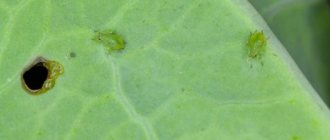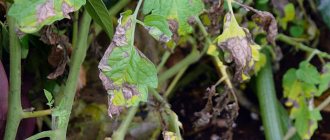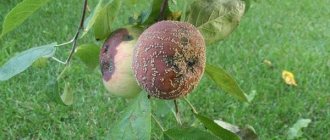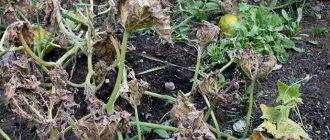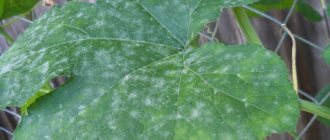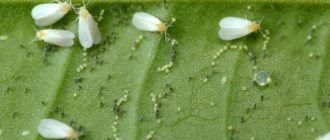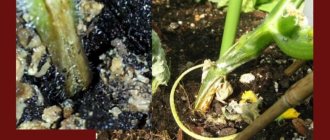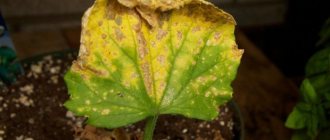Unfortunately, everyone who wants to grow a good harvest or a beautiful garden with flowers on their plot is familiar with the other side of this matter, namely, caring for plants on which it is tedious to spend a lot of time and effort. These living organisms are also susceptible to diseases and attacks by pests, and they cannot cope without us, especially since they die very quickly, since everything that interferes with their normal development and growth ultimately kills them. I really want the garden and harvest to be healthy, but there is no escape from bacteria and viruses. There are rare diseases that you may not encounter, but there are quite common problems that can appear unexpectedly and affect plants; one of the common viruses is tobacco mosaic. This disease is known and common, even if you have not yet encountered it, you should learn more about its signs in order to quickly respond if it appears on your site.
Tobacco mosaic virus
Tobacco mosaic virus is considered a disease of nicotine plants, but in total it can affect a large range of living organisms, there are more than 300 plants that suffer from tobacco mosaic. Therefore, at one point you can find it in your garden, both on a tobacco plant and on an ordinary tomato. Like all viruses, tobacco mosaic is destructive to the fruit and plant; eventually it infects the crop and it will no longer be suitable, so you should monitor the health of the plants and respond in case of illness. Even with a large spread, you can save the remaining healthy area, as you can find out exactly how below. If you don’t have such a problem yet, you can try to protect your harvest using known methods of prevention. Since tobacco mosaic is a problem that many have already encountered, it has been well studied, therefore, many methods have been invented to combat it, which you can do with your own hands at the moment. Of course, if you are familiar with the causes of this disease, it will be easier for you to protect your garden, so this is also worth paying attention to.
We recommend reading:
White mustard as green manure
Tobacco mosaic virus
Signs of the disease
Tobacco mosaic virus is a disease that spreads as a finger parasite and gradually infects the plant. It easily exists in completely different regions, since it has no special preferences in choosing a climate; its spread occurs easily in any conditions. However, the virus is simple, and getting rid of it is also easy. The virus is truly fatal to plants and infects them completely; you can recognize it by its special characteristics. The main effect of the virus is on the plant’s ability to photosynthesize, which is an important factor in its life and development; accordingly, by interrupting this function of the plant, the virus destroys it. The most obvious sign will be a change in the color of the leaves; they will take on strange patterns with white or yellowish streaks. This discoloration of the sheets occurs as if in streaks, the sheet becomes lighter, has a strange color and dries out.
Large yellow spots can also be a sign that this is the same process of discoloration. Many compare divorces with this virus to a mosaic, which is the basis of the name; this will help you immediately understand what you are faced with. After the virus has spread, it slowly disrupts the life of the plants, the leaves will gradually become thinner and dry out. Sometimes they first become deformed, bend, become thinner, etc. If a virus infects a vegetable crop, the fruit will stop developing; tomatoes, for example, will be small in size; they will no longer grow and will not be able to ripen normally.
Symptoms of the disease
Viruses that enter healthy plant cells destroy chlorophyll, the green pigment responsible for photosynthesis. As a result, the affected areas of the leaves fade and turn beige or emerald. The alternation of healthy and diseased areas gives the leaf a marbled color, which is called “mosaic”.
Healthy plant cells begin to actively divide so that nutrients continue to flow into the bush. As a result, the leaves seem to swell with large tubercles. In the future, this leads to thinning of the skin, which ceases to cope with its protective functions. Then bacteria penetrate through it, and moisture evaporates easily. The leaf dries out.
Which plants are susceptible to infection?
As mentioned above, the range of plants that can be infected with the virus is quite wide; all the main crops that our gardeners love so much, for example, peppers and tomatoes, are prone to this disease. The problem is that the virus itself can arise due to completely different conditions that sometimes cannot be foreseen. Sometimes the seeds themselves can be infected, which means they will produce already infected plants. Also, mosaic can come to your garden with pests; ticks and bedbugs are often carriers of this disease. At the moment when the plant is vulnerable, when planted or damaged, it can become ill with this virus; there will simply be favorable conditions for its development. Sometimes the virus gets in with pollen, which happens more often in open areas, but such a problem can also arise in a greenhouse due to the factors mentioned above.
We recommend reading:
How to grow champignons at home
Tobacco mosaic virus
Mosaic on plants
Mosaic on plants can be caused by different viruses. In order to destroy diseased specimens and save healthy ones, you need to know what signs accompany plant infection with mosaic.
Mosaic on fruit trees
Fruit trees are most often affected by subcutaneous spotted mosaic, manifested by the following symptoms:
- Potatoes: treatment before planting
- cracks appear on the bark of the main branches;
- a mosaic pattern is formed on the leaves of the trees;
- the fruits are deformed, dense areas appear in them, the flesh darkens;
- tree productivity decreases sharply.
Mosaic on flowers
A mosaic of rose bushes can appear like this:
- yellow streaks and arrows appear on the leaves and young shoots;
- the flowers become smaller, become sluggish, green appears on them, most of the flowers fall off;
- flowering times are reduced;
- the disease quickly spreads to neighboring bushes.
Mosaic on berry bushes
Berry crops (raspberries, currants, gooseberries, grapes and others) are affected by a vein mosaic, the characteristic features of which look like this:
- chlorosis appears on the leaf veins, that is, marks of different shades appear;
- the edges of the leaves curl up, the foliage looks as if scorched by fire;
- the development of young shoots slows down;
- angular spots cover all the leaves of the bush.
Mosaic on potatoes
Striped mosaic that affects potatoes has the following symptoms:
- the upper tissues and stems are covered with clearly defined longitudinal stripes;
- ground parts become rough and decrease in size;
- tubers acquire a spindle shape and lose their taste;
- The crop yield decreases and the plants die.
Mosaic of tomatoes
Tomato mosaic is often called burn. It can deprive you of 20% of your harvest. The disease manifests itself as follows:
- tomato leaves become bright and spotted;
- the fruits become covered with dark and light green marks, become deformed, and the flesh in them turns black and rots.
In the photo: Viral mosaic on cucumber leaves
Mosaic of cucumbers
Most often, cucumbers are affected by common mosaic, the symptoms of which are as follows:
- the stems of the plants become bent, and spots on the leaves appear during the seedling period;
- Over time, the leaves dry out and curl;
- longitudinal cracks form in the stems of cucumbers;
- the bush forms fewer and fewer flowers, and they become small;
- the greens curl and turn yellow;
- the stem becomes almost transparent, faded, the bush becomes discolored and withers.
Cabbage mosaic
Cabbage mosaic affects all varieties of the crop and has the following symptoms:
- the veins on the leaves become lighter, small spots of necrosis appear on them;
- plant tissue wrinkles;
- the stem becomes brittle and breaks.
Mosaic of radish and radish
On cruciferous root crops, mosaic is manifested by the following signs:
- White rot: treatment and prevention of sclerotinia
- the leaves are covered with a mosaic pattern, the plates are deformed, the veins darken;
- The growth of root crops slows down and black spots form on them.
Mosaic on peas
Both ordinary mosaic and deforming mosaic can develop on peas. Symptoms:
- bruising and curling of tissues becomes noticeable;
- yellow and white markings appear on the leaves;
- plant growth slows down;
- spots appear on the pods, they turn black, begin to rot, and the peas acquire a yellow tint.
Mosaic on beans
An ordinary mosaic on beans looks like this:
- leaves become covered with irregularly shaped spots, curl and bubble;
- the stem of the plant is affected, a rosette of diseased leaves is formed in its lower part;
- the seedlings do not grow, remaining dwarf;
- the roots also become infected with the virus, and the fruits acquire an unhealthy dullness.
How to treat
To definitely save the harvest, you need to act immediately. First of all, take care of the infected crop; it can no longer be saved; remove it from the site and burn it. All plants should be treated with whey, it is done by mixing whey with water 100 ml to 1 liter, plus you will need to add microfertilizers. Also, to protect the crop from the virus, you will have to replace the top layer of soil, this must be done before spraying. You can add a few more drops of pharmaceutical iodine to the serum. Afterwards, you will need to treat the plants again with a fungicide solution. The struggle process may seem long to you, but you will definitely save the remaining crop without harming it.
Tobacco mosaic virus
Fighting mosaic
Measures to combat mosaic
Unfortunately, there are still no effective ways to combat viruses that cause mosaic. If the lesion is superficial, you can try to cut out the diseased parts with a sterile instrument, grabbing healthy tissue, then all plants should be treated leaf by leaf with a solution of 75 g of Karbofos in 10 liters of water: this measure will help protect at least neighboring healthy plants from the disease. However, in case of severe infection, diseased specimens must be removed and burned - the virus must be destroyed for sure.
When working with infected plants, be careful: be sure to boil the clothes you were wearing while working with infected plants with detergent, since the mosaic virus can persist for several years.
Mosaic disease - prevention
The fight against mosaic is carried out only by preventive and agrotechnical measures. Here is an approximate list of measures to protect plants from mosaic pathogens:
- growing the most resistant plant varieties to viral diseases;
- use only healthy and disinfected seed and planting material;
- planting seedlings according to a scheme developed by specialists so that each plant has access to air;
- timely destruction of pests and weeds on which harmful insects settle;
- disinfection of garden tools for half an hour in a solution of 4 tablespoons of copper sulfate or 2 tablespoons of potassium permanganate in a liter of water;
- destruction of diseased plants along with a lump of earth and disinfection of the area of soil on which they grew with a strong solution of potassium permanganate;
- the use for agriculture of the area where the mosaic was discovered is not earlier than quarantine.
Prevention
So that you do not have such a problem again, or simply never have a mosaic virus in the area, you can take a few simple steps for prevention. Always keep an eye on the seeds, leave only healthy ones that are not in doubt. Always disinfect equipment to prevent the virus from entering. In greenhouses, you always need to follow the rules so that bacteria do not multiply; do not be lazy to change the top layer of soil annually. The same tomatoes need vaccination to strengthen the immune system. Always remove weeds and ensure that pests do not enter the crop.
Author of the publication
offline 1 year
History of discovery
The palm in the discovery of this virus (and viruses in general) belongs to the scientist Dmitry Ivanovsky. Scientists filtered water with the virus to avoid contamination, but did not know that it was there. Filtering failed. Then, in 1892, the assumption arose that there was either poison in the water or some microscopic creatures that were not visible under a microscope. After the invention of the electron microscope in 1930, scientists confirmed the latter version. The first purified TMV preparation from an infected tobacco plant was obtained in 1935 by Wendell Stanley.
Mosaic Protection Plan
You need to understand that it is almost impossible to cure an infected plant. Therefore, the main task is to prevent the spread of the virus in the area.
Despite the variety of viruses that cause spotting, they all have the same ways of spreading. And accordingly, methods of prevention and protection are similar for different cultures.
To prevent infection, you must adhere to the following action plan:
- carry out pre-sowing seed treatment;
- disinfect the soil before planting crops susceptible to the disease;
- treat the garden with insecticides and acaricides that act on sucking insects (disease carriers);
- treat with preventive fungicides.
